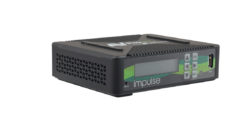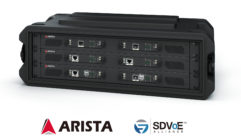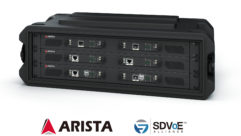
NewTek in the Worship Space, Part 1
Aug 1, 2013 11:58 AM,
With Bennett Liles

Listen to the Podcasts
|
Editor’s note: For your convenience, this transcription of the podcast includes timestamps. If you are listening to the podcast and reading its accompanying transcription, you can use the timestamps to jump to any part of the audio podcast by simply dragging the slider on the podcast to the time indicated in the transcription.
With a big congregation, the Community of Christ Church in Independence, Mo., also plays host to local graduations and many other events. The tech crew has to be ready for anything, and they have a long history of using NewTek video gear. Bob Haworth is going to give us the details on how the church does sound and video, coming right up on the SVC Podcast.
SVC: Bob, thanks for being with us on the SVC Podcast from the Community of Christ Church in Independence, Mo. You’ve got some NewTek video switching gear out there. Tell me about Community of Christ Church. What sort of worship style do they have there?
Bob Haworth: We have a number of different worship styles. We’re an international church of about 250,000 members.
I did see one picture on your website and it looks like a pretty big place. How big a congregation do you usually get in there on a normal Sunday?
On a normal Sunday, our denomination meets in local congregations, so we don’t really use the facility on Sundays unless we have a special visit by a congregation that wants to use the worship spaces. Our campus is really two large buildings; the auditorium, which is the older of the two, was built in 1926—was started—and over several decades it was completed and the pictures that you saw on the Web were basically how the room has stood since about 1958, 1960. [Timestamp: 1:50]
Well, it looks like fairly modern architecture. I don’t know how many acoustic challenges that may pose for you. How is your sound system set up? Do you have separate control over front of house and stage monitoring or do you do it all from one location and mixer?
We do everything sound system-wise from one location normally. Because it is a large facility—we have 5,700 seats—we do a number of different types of programs and services. We use the facility more as a public use facility for the local area. We’ve just finished our graduation season with 17 college, university, and high school graduations. [Timestamp: 2:31]
Ok, that makes things interesting because you may have a lot of different people operating the equipment then or do you have your own tech crew?
I have a staff that ranges up to about 24 people depending on what we’re doing and what time of year we’re doing it. Our average crew is about 12 to 14. [Timestamp: 2:49]
What type of mixer do you use at the front of house? It sounds to me as though it has to be able to handle a lot of different setups.
We’re using Yamaha M7-48 with EtherSound stage boxes, and then the other facility we’re also using an M7 in the house mix position on that location. All together we have two LS9-16’s, an LS9-32 that we use for monitor mix when we need to. We also do an M7 for our studio board as well and all of those locations are connected with EtherSound. [Timestamp: 3:27]
NewTek in the Worship Space, Part 1
Aug 1, 2013 11:58 AM,
With Bennett Liles
Oh, well that must be a good situation if you’ve got pretty much the same people working the tech side all the time. Right, and that keeps training on different pieces of equipment down to a minimum. And even the way we’ve laid the systems out, the submixes and the various inputs we’ve pretty well patterned the same on the consoles. Inputs 17 and up will be wireless mics. Inputs 48 and down will be tape and video playback inputs. One through 16 are our primary mic inputs. So it’s very easy for an operator to sit down and run each individual room because the input structure and the output structure is pretty much the same. [Timestamp: 4:14]
Well, that’s probably the exception rather than the rule to have it that well organized, but if you’re not, with that many different things coming in there, it could get out of hand pretty fast. Now, how do you do the video? Is it mainly for IMAG or broadcast, webcast, or what are you doing with that?
We do a little bit of everything. We generally record almost every service or event so the video does both our audio recording and our video recording. IMAG is basically what we’re doing in the auditorium. We have three screens; they’re 24 by 14ft. We’ve got three projectors, 16,000-lumen Digital Projection projectors on them, and each one of those is then sourced to a NewTek switcher. The two side screens are connected to a XD455 and the center one is to our XD850. [Timestamp: 5:10]
And what kind of video format do you feed up to the screens? How is it conveyed up there?
We developed that system in 2000, the video system, and over the process of several years we’ve developed the NewTek products to control our screens. So we’re mixing video, we’re using standard-definition cameras with some high-def cameras being added in as we go. We rent the equipment—high-def cameras—when needed. So I can put my hands on six high-def cameras at this time if I need to and most of the stuff we’re doing is IMAG with Power Point or CG backup. [Timestamp: 5:51]
Is the PowerPoint for song lyrics and things like that?
Song lyrics. The high schools like to have the graduates’ pictures. You know, it’s high school and it’s the first real graduation that a lot of the kids have done. They’ll have their baby picture and high school graduation picture. The school will prepare that on a PowerPoint and then we’ll bring it into the TriCaster ahead of time using IVGA Pro and we’ll record it the afternoon of their graduation. We do very little editing on that presentation. It’s just basically a quick capture and then a playback that we loop while the audience is coming in and the kids are gathering. They get to see it in the space that they gather in and get lined up to march in. [Timestamp: 6:38]
Where do you keep the NewTek gear? Where do you keep the switcher and all the video control stuff?
The auditorium has quite a history. My office is currently located in a radio studio from the 1940’s, and as part of that space we’ve also adapted it to house our TriCaster equipment for the main room. We’re down and behind the actual stage area. [Timestamp: 7:03]
And you’ve been through several generations of NewTek video switching gear there. What models of that equipment have you used in the church before?
We actually did a program in about ’94 or ’96 and for the program we rented a Video Toaster on the Amiga platform back then. We’ve been watching that product ever since and in 2006 we bought our first TriCaster Pro, the little three-input unit and we bought a VT 4 and upgraded it to a five the next year. [Timestamp: 7:40]
And you’ve probably gotten used to the new features on the NewTek gear as they’ve come along. Seems like it’s pretty simple to use.
Right. It is. It’s very easy to use. We do all of the lighting. We do lighting design. We do all of the sound, sound design, staging, and video with that crew of 10 to 12. [Timestamp: 7:58]
No problems in training people on it. Now, you’ve had the new TriCaster 8000 in there a few times for the big stuff, right?
We had a TriCaster on loan. Our dealer is very easy to work with and when we have a production that’s a little bit outside of what we can do with the 850 and the 455’s, he’ll loan us his 8000 for that event. We do all kinds of stuff here. Truman Library is very close to us and every two years or so they have a large event where they have a guest speaker in and we’ve done President Clinton, we’ve done a number of different well-known political figures. The Chiefs owner, Lamar Hunt, his funeral services were held here. And when we need to do those kind of services and those kind of programs, our supplier’s been very, very generous in letting us have the equipment. [Timestamp: 8:56]
The 8000 I think has a feature called hotspots on it?
Yes, it does.
How does that work?
What we used it for, during our international conference we use a deaf signer and put the deaf signer in a small studio area and we set them up with the hotspot motion to be able to swipe and actually do the transition to take them on and off-screen so that when they’re changing seats, changing personnel or they don’t need to be on screen, they’re not just sitting there as an entity onscreen doing nothing. And they don’t also have to that way get the attention of the switcher or anything. They can gesture to the side, it dissolves them out of the picture. We also set up a second hotspot that would move them from the bottom right to the top left depending on how the PowerPoint was designed or what other elements were onscreen at the time so they could actually shift where they were on the screen. [Timestamp: 10:02]
Oh that’s great. So your folks don’t have to be totally familiar with the format of each show as much as the people coming in with it. You can just give the clients a degree of control over what they’re doing with the hotspot feature.
Right. And they took a little training with it because they’re not used to that kind of accessibility, and once they started doing it they were very comfortable with it. It was very natural. [Timestamp: 10:24]
OK, well it sounds like a pretty effective system and easy to train people on. Thanks for telling us about it, Bob. Bob Haworth at the Community of Christ Church in Independence, Mo. Thanks for being with us.
All right. Thank you.









